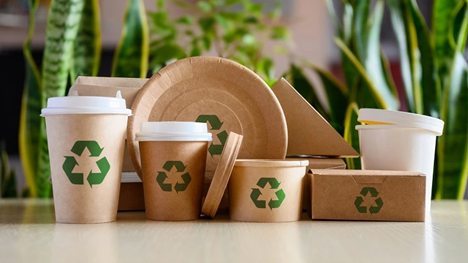Green Packaging a Key Part of Sustainable Manufacturing

(Source: www.enterprisenation.com)
What is Green Packaging?
Eco-friendly packaging, sustainable packaging, and green packaging are phrases that refer to the same concept: packaging designed to minimize environmental impact as much as possible.
This minimal impact is accomplished through various methods: reducing the amount of packaging waste produced, utilizing materials that can be recycled or are biodegradable, and employing renewable energy sources in the manufacturing process (Vivien, 2023).
The Impact of Packaging on The Environment
We’ve all felt frustrated by packages that come in boxes far too big for the item inside, filled with unnecessary padding. Clearly, using excessive packaging is wasteful.
Additionally, regardless of whether the packaging fits properly, various materials are often utilized for a single shipment: for instance, tape, cardboard, styrofoam inserts, and bubble wrap. Many of these materials contain plastics. In fact, the United Nations Environment Programme reports that approximately 36% of all plastics created are used for packaging. Furthermore, packaging is the leading source of single-use plastic waste globally.
The production of plastic ranks among the most energy-demanding manufacturing processes globally. Therefore, by the time a conventionally packaged parcel arrives at a customer’s home, it has already made a significant contribution to the climate emergency.
Frequently, this packaging is discarded in landfills or becomes litter. Plastic can require up to 1,000 years to decompose, leading to environmental accumulation that harms soil, contaminates groundwater, and endangers marine life. Microplastics can find their way into the human body, posing potential serious health risks—and they have even been detected in the placentas of newborns (Vivien, 2023).
Benefits of Green Packaging
- Minimize Pollution
Eco-friendly packaging is crucial in our shared duty to cut down pollution. Tackling the detrimental impacts of standard packaging materials enables us to create a positive difference.
A primary focus is on lessening plastic waste, which is a significant factor in pollution, since traditional plastic packaging frequently ends up in landfills or oceans, lasting for centuries. In contrast, eco-friendly packaging employs biodegradable, compostable, or recyclable materials that decompose naturally, greatly lowering pollution levels (Matt Dobson, 2025).
- Simple Disposal
The kind of packaging you choose might differ, but it should either be suitable for composting or recycling. If any of your customers or colleagues have access to compost facilities, you can convert the waste packaging into compost. If the packaging is clearly marked as recyclable, it can be placed in your recycling bin for future use.
- Versatile And Flexible
Eco-friendly packaging is pretty versatile and can be re-used and re-purposed in most major industries that involve packaging. Whatever you are looking to package right from meats to electronic devices, there will be an eco-friendly type of packaging that will meet their needs and reduce costs (Green Business Benchmark, 2024).
References:
GWP Group. (2025). Green Packaging: 7 Crucial Benefits for Your Business. Retrieved from https://www.gwp.co.uk/guides/environment/green-packaging/
Green Business Benchmark. (2024). 10 Environmental Benefits of Using Green Packaging. Retrieved from https://www.greenbusinessbenchmark.com/archive/10-green-packaging-advantages
DHL. (2023). Green Packaging and Why It’s Important to Your Business. Retrieved from https://www.dhl.com/discover/en-id/logistics-advice/sustainability-and-green-logistics/sustainable-packaging-in-logistics




Comments :